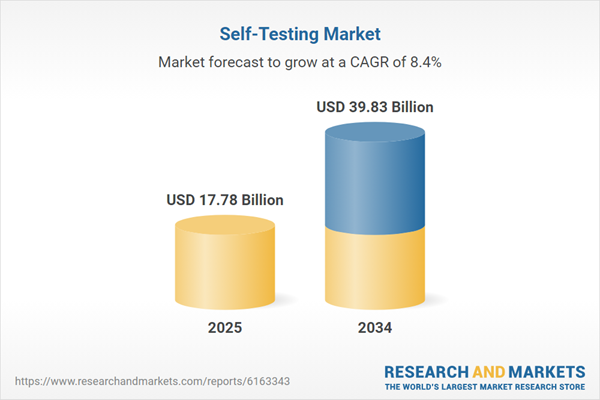Self-Testing: Introduction
Self-testing is the procedure which is performed with or without the supervision of healthcare professionals just as the name suggests. Self-testing can be done to perform a range of medical tests such as, pregnancy test, HIV, colon cancer, blood pressure, and blood sugar levels, among others. Self-testing kits are readily available on retail or online pharmacies which are convenient and easy to use.Global Self-testing Market Analysis
The improvement in coverage of testing for several medical across the globe has been a solid proof of the advantage of using and providing self-testing kits. This evidence the strongly supports the market growth of self-testing. The increasing awareness and demand for point-to-care treatment approaches are contributing to the increased market demand as well. The increasing geriatric population is also a major factor in the growth of the market, as people in old age are the main target of self-testing kits, devices as they provide convenience of performing the test on their own place without having to move out of the house.The increasing technological developments in the area of self-testing is majorly responsible for the global self-testing market growth. For example, Am Israel based startup has developed SaliStick, which is a cutting-edge pregnancy testing kit that does not require urine or blood sample. This innovational product tests patient's saliva and provide quick result within 10 minutes. By 2024, this product is expected to be available in Israel, Europe, South Africa, and the United Arab Emirates.
Global Self-testing Market Segmentations
Self-Testing Market Report and Forecast 2025-2034 offers a detailed analysis of the market based on the following segments:Market Breakup by Product Type
- Diagnostic Kits
- Diagnostic Device
- Diagnostic Strips
- Others
Market Breakup by Applications
- Diseases Specific Products
- Diabetes
- HIV
- Allergies
- Genetic Disorders
- Others
- Wellness and Fitness Products
- Fitness Tracking Devices
- Vitamins Deficiency Tests
- Others
Market Breakup by Usage
- Disposable
- Reusable
Market Breakup by Distribution Channels
- Drug Store
- Retail Pharmacies
- Online Pharmacies
- Supermarket/Hypermarket
- Others
Market Breakup by Region
- North America
- Europe
- Asia Pacific
- Latin America
- Middle East and Africa
Global Self-testing Market Overview
The self-testing market has been witnessing a significant growth due to the increasing geriatric population worldwide. There has been a surge in the demand for self-testing kits in the market due to the convenience and privacy provided by the self-testing kits. The self-test kits are also available easily over the counter or on prescription basis in pharmacies such as online, offline and retail pharmacies, which further aids the global self-testing market share.The ability to generate quick results of self-testing kits is also a major factor which escalates the demand for them in the market. Tests such as HIV, hepatitis C, urinary tract infections, colon cancer can be performed using self test kits. The increasing development of self-testing kits is also associated with the growth of self-testing market globally.
North America is leading the global market and is expected to lead throughout the forecast period. The Ministry of Health, Neman-Pharm, and the U.S. Agency for International Development (USAID) will collaborate to distribute free HIV self-testing kits.
Self-Testing Market: Competitor Landscape
The key features of the market report include patent analysis, grants analysis, clinical trials analysis, funding and investment analysis, partnerships, and collaborations analysis by the leading key players. The major companies in the market are as follows:- PRIMA Lab SA
- bioLytical Laboratories Inc.
- OraSure Technologies, Inc.
- Nectar Lifesciences Ltd.
- Piramal Enterprises Ltd.
- Cardinal Health
- Johnson & Johnson Services, Inc.
- B. Braun Melsungen AG
- BD
- Beckman Coulter, Inc.
This product will be delivered within 3-5 business days.
Table of Contents
Companies Mentioned
- PRIMA Lab SA
- bioLytical Laboratories Inc.
- OraSure Technologies, Inc.
- Nectar Lifesciences Ltd.
- Piramal Enterprises Ltd.
- Cardinal Health
- Johnson & Johnson Services, Inc.
- B. Braun Melsungen AG
- BD
- Beckman Coulter, Inc.
Table Information
| Report Attribute | Details |
|---|---|
| No. of Pages | 350 |
| Published | July 2025 |
| Forecast Period | 2025 - 2034 |
| Estimated Market Value ( USD | $ 17.78 Billion |
| Forecasted Market Value ( USD | $ 39.83 Billion |
| Compound Annual Growth Rate | 8.4% |
| Regions Covered | Global |
| No. of Companies Mentioned | 10 |









